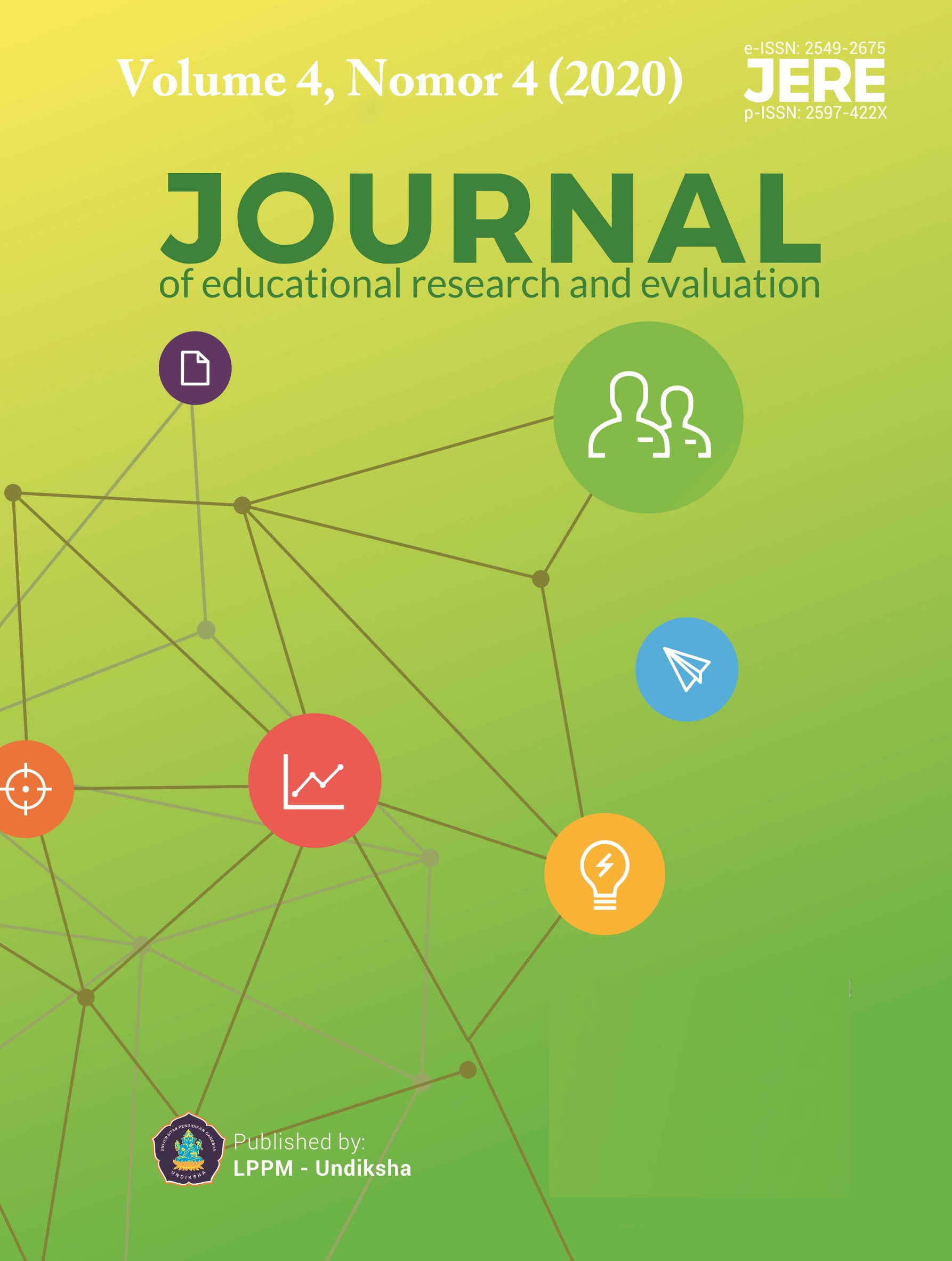Evaluation of Photo Math in Teaching Elementary Algebra
DOI:
https://doi.org/10.23887/jere.v4i4.29749Keywords:
photomath, mobile application, math educationAbstract
This study aims to evaluate “Photo Math” in teaching Elementary Algebra. Specifically, it aimed to identify the effect of teaching Elementary Algebra with the use of “Photo Math”. To achieved these objectives, the researchers used qualitative, quantitative and experimental design. This was conducted through a separate teaching demo in Elementary Algebra of the two Grade 7 sections. Pre-test was administered before the conduct of the demo and post-test after the teaching demo. The study showed that there was a significant difference between the pre-test and post-test results of the section with “Photo Math” as intervention. Moreover, there was also a significant difference between the pre-test and post-test results of the section without the said application as intervention. However, it showed that there was no significant difference between the two section. The first section showed that there was an effect to the performance of the students when “Photo Math” was applied as teaching tool but it was not fully claimed when compared with the traditional method of teaching. This was because the sample size of the study is small so it was recommended to have a larger number of sample size to see the effect of “Photo Math” in teaching Elementary Algebra. The study implied that Photo math as a teaching tool had an effect on teaching elementary algebra.
References
Anghileri, J. (2006). Scaffolding Practices that Enhance Mathematics Learning. Journal of Mathematics Teacher Education, 9, 33–52. https://doi.org/10.1007/s10857-006-9005-9
Asarta, C. J., & Schmidt, J. R. (2020). The effects of online and blended experience on outcomes in a blended learning environment. Internet and Higher Education, 44(June 2018), 100708. https://doi.org/10.1016/j.iheduc.2019.100708
Casinillo, L. F. & Casinillo, E. L. (2020. (2020). Modelling Experiences and its Factors in General Mathematics: The Case of Grade 11 Students. Indonesian Journal of Educational Research and Review, 3(2), 25–34.
Chansky, N. M. (1966). Anxiety, Intelligence and Achievement in Algebra. The Journal of Educational Research, 60(2), 90–101. https://doi.org/10.1080/00220671.1966.10883444
Chazan, D., Yerushalmy, M., & Leikin, R. (2008). The Journal of Mathematical Behavior An analytic conception of equation and teachers ’ views of school algebra. 27, 87–100. https://doi.org/10.1016/j.jmathb.2008.07.003
Chen, S., Lo, H. C., Lin, J. W., Liang, J. C., Chang, H. Y., Hwang, F. K., Chiou, G. L., Wu, Y. T., Lee, S. W. Y., Wu, H. K., Wang, C. Y., & Tsai, C. C. (2012). Development and Implications of Technology in Reform-based Physics Laboratories. Physical Review Special Topics - Physics Education Research, 8(2), 287–302. https://doi.org/10.1103/PhysRevSTPER.8.020113
Chiu, T. K. F., & Mok, I. A. C. (2017). Learner expertise and mathematics different order thinking skills in multimedia learning. Computers & Education. https://doi.org/10.1016/j.compedu.2017.01.008
Hall, V. (1990). A Review of Computer Algebra and its Educational Implications in the Teaching of Mathematics. 5(1989), 243–259.
Litke, E. (2020). Instructional practice in algebra : Building from existing practices to inform an incremental improvement approach. Teaching and Teacher Education, xxxx, 103030. https://doi.org/10.1016/j.tate.2020.103030
Lynch, K., & Star, J. R. (2014). The Journal of Mathematical Behavior Exploring teachers ’ implementation of comparison in Algebra I. Journal of Mathematical Behavior, 35, 144–163. https://doi.org/10.1016/j.jmathb.2014.07.003
Ozdag, H., & Aygor, N. (2012). Undergraduate students ’ performances in linear algebra : factorization of a determinant of n * n dimensional matrices. 46, 125–129. https://doi.org/10.1016/j.sbspro.2012.05.080
Richardson, K., Berenson, S., & Staley, K. (2009). The Journal of Mathematical Behavior Prospective elementary teachers use of representation to reason algebraically. 28, 188–199. https://doi.org/10.1016/j.jmathb.2009.09.002
Saprudin, S., Liliasari, L., Setiawan, A., & Prihatmanto, A. (2019). The effectiveness of using digital game towards students’ academic achievement in small and large classes: A comparative research. International Journal of Learning, Teaching and Educational Research, 18(12), 196–210. https://doi.org/https://doi.org/10.26803/ijlter.18.12.12
Sarmiento, D. H., & Orale, R. L. (2016). Senior high school curriculum in the Philippines, USA and Japan. Journal of Academic Research, 1(3), 12–23.
Srisawasdi, N., & Sornkhatha, P. (2014). The Effect of Simulation-based Inquiry on Students’ Conceptual Learning and Its Potential Applications in Mobile Learning. International Journal of Mobile Learning and Organisation, 8(1), 28–49. https://doi.org/10.1504/IJMLO.2014.059996
Taylor, P., & Sangwin, C. J. (2007). International Journal of Mathematical Assessing elementary algebra with. October 2014, 37–41. https://doi.org/10.1080/00207390601002906
Trouche, L., Gitirana, V., Miyakawa, T., Pepin, B., & Wang, C. (2018). Studying mathematics teachers interactions with curriculum materials through different lenses : Towards a deeper understanding of the processes at stake. International Journal of Educational Research, September, 1–15. https://doi.org/10.1016/j.ijer.2018.09.002
Downloads
Published
How to Cite
Issue
Section
License
Authors who publish with the Journal of Evaluation and Research in Education (JERE) agree to the following terms:
- Authors retain copyright and grant the journal the right of first publication with the work simultaneously licensed under a Creative Commons Attribution License (CC BY-SA 4.0) that allows others to share the work with an acknowledgment of the work's authorship and initial publication in this journal.
- Authors are able to enter into separate, additional contractual arrangements for the non-exclusive distribution of the journal's published version of the work (e.g., post it to an institutional repository or publish it in a book), with an acknowledgment of its initial publication in this journal.
- Authors are permitted and encouraged to post their work online (e.g., in institutional repositories or on their website) prior to and during the submission process, as it can lead to productive exchanges, as well as earlier and greater citation of published work. (See The Effect of Open Access)











